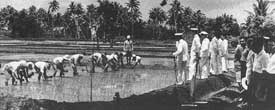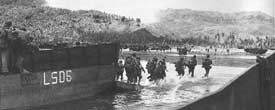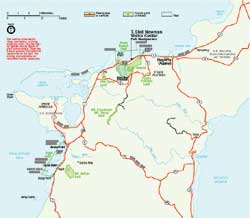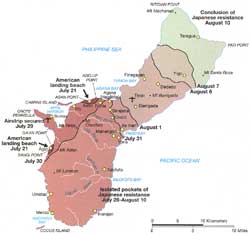|
WAR IN THE PACIFIC National Historical Park |
U.S. Department of the Interior National Park Service |

|

| Guam 1941-1944: Conquest and Liberation |
The Japanese conquest of Guam began about an hour after the attack on Pearl Harbor, when Saipan-based Japanese dive bombers launched the first in a series of raids on the Island. At that time Guam's total protection consisted of 153 Marines, 271 U.S. Navy personnel, 134 civilian construction workers, and 247 members of the local Chamorro Insular Force Guard and the Naval Militia. (Chamorros are the indigenous people of Guam.) The garrison had no artillery, only a few .30-caliber machine guns, and various small arms. For two days the Japanese bombed and strafed the island and its defenders. In the early morning hours of December 10, a special Japanese naval landing party of about 400 men from the 5th Defense Force based on Saipan began landing at Dungca's Beach in Agana Bay. At the same time, a Japanese Army unit known as the South Seas Detachment landed on the beaches of Aporguan, Tumon, Togcha, Agat, and other areas. The Insular Guard made a gallant attempt to stop the Japanese advance at the Plaza de Espana in Agana (now Hagåtña) but was soon driven back. By 5:45 a.m. Capt. George J. McMillin, USN, the Island's governor, realized that his tiny command was no match for the invasion force and began to surrender his post and the island.
Guam remained in Japanese hands for two and a half years and Chamorros were forced to endure the hardships of military occupation in a war not of their making. For the first four months the island was controlled by army troops, who were housed in schools and government buildings in Agana. The island was renamed Omiya Jima (Great Shrine Island) and Chamorros were required to learn the Japanese custom of bowing. Japanese yen became the island's currency, and civilian affairs were handled by a branch of the army called the minseisho. Cars, radios, and cameras were confiscated and food was rationed until supplies became exhausted. Chamorros suspected of hiding family members wanted by the Japanese, or of aiding the few Americans that did not surrender, were harassed, beaten, or tortured, and, in some instances, executed by order of the authorities.
Control of the island came under the Imperial Japanese Navy in March 1942. The keibitai, as it was known, governed the populace for about 19 months. Chamorros were allowed to remain on their farms and trade for products they needed. Social activities included parties, Japanese movies, and sports competitions. Mass meetings were held in Agana to reinforce the "Nippon Seishen" (spirit of Japan). Schools were reopened and Chamorros were required to learn the Japanese language and customs. English was forbidden. Adults and children were taught reading, writing, math, and Japanese games and songs.
In early 1944, with the war going badly for Japan and an American invasion threatening, the Japanese Army returned to Guam, bringing with it a new and stricter form of government—the kaikon tai. Social activities were terminated, schools were closed, and Chamorro men, women, and children over the age of 12 were forced to work long hours in the fields, repair or build airstrips and defense installations, and dig hundreds of Japanese shelter caves, many of which are within the boundaries of today's park. Chamorros, laboring at bayonet point, were mistreated and, in some cases, executed after completing defense installations. Without warning, 10,000-15,000 Chamorros, young and old, were forced to march with only the belongings they could carry to concentration camps in Guam's central and southern jungles. With inadequate shelter, little food, and no sanitary facilities, life in these camps was miserable. Despite the hardships, however, incarceration proved to be a blessing in disguise. Had they not been moved, many Chamorros would have been killed by the American pre-invasion bombardment and the Japanese crossfire.
| The Guam operation "was brilliantly and valorously conducted and resulted in the recovery of important American Territory and the liberation of loyal people. Well Done." —Admiral Chester W. Nimitz |
On the morning of July 21, 1944, after one of the longest and heaviest pre-assault naval bombardments of the war, the American recapture of Guam began with simultaneous landings at Asan and Agat beaches by 55,000 men of the 3rd Marine Division, 1st Provisional Marine Brigade, and 305th Regimental Combat Team of the 77th Army Infantry Division. By day's end, despite some initial confusion over landing sites and stiff resistance by the island's 18,500 Japanese defenders, both beaches had been secured. In the three weeks that followed (see map at far left), the Americans cleared Orote Peninsula and secured Fonte Plateau. They then moved north toward Agana, Barrigada, Mount Santa Rosa, and on to Ritidian Point, where the island was declared secure. The recapture of Guam cost more than 7,000 American and about 17,500 Japanese casualties. Japan's grip on the Marianas was broken and the end of the war was now just slightly over a year away.
 |
 |
| Lt. Commander Homura, Governor of Japanese-occupied Guam, inspects Chamorro workers planting rice. Chamorro and Korean laborers were forced to work in the fields to produce food, clear runways for airstrips, and dig hillside caves, trenches, and other Japanese defense fortifications. | Assault troops of the 3rd Marine Division wade ashore under fire at Asan Beach, July 21, 1944. Their objective: capture the cliffs and high ground immediately inland and prepare for further operations to the east and southeast. |
 |
| Park Map. (click on image for an enlargement in PDF format ~1.2mb) |
